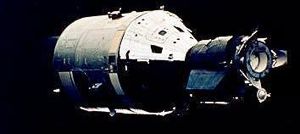
Home - Search - Browse - Alphabetic Index: 0- 1- 2- 3- 4- 5- 6- 7- 8- 9
A- B- C- D- E- F- G- H- I- J- K- L- M- N- O- P- Q- R- S- T- U- V- W- X- Y- Z
Apollo ASTP Docking Module
 Apollo ASTP / DM Credit: NASA |
AKA: Docking Module. Status: Operational 1975. First Launch: 1975-07-15. Last Launch: 1975-07-15. Number: 1 . Gross mass: 2,012 kg (4,435 lb). Height: 3.15 m (10.33 ft). Span: 1.40 m (4.50 ft).
The docking module was 3.15 m long, 1.4 m maximum diameter, and weighed 2,012 kg. Apollo's cabin atmosphere was 100 percent oxygen at 0.34 atmosphere pressure, while that of Soyuz was nitrogen/oxygen at 1.0 atmosphere. Transfer between these two atmospheres would require pre-breathing of pure oxygen to purge the blood of suspended nitrogen. This was avoided by lowering the Soyuz pressure to 0.68 atmospheres pressure. The docking module served mainly as an airlock to raise or lower the pressure between 0.34 and 0.68 atmospheres when moving from one spacecraft to the other. This was done through the use of pressure equalization valves with both hatches closed.
The docking module pressure vessel was formed from a welded cylinder of 1.58 cm thick aluminum, with a tapered bulkhead and tunnel section on the command module and a machined base assembly and bulkhead on the Soyuz end.
A systems module inside the docking module contained control and display panels, VHF/FM transceiver, environmental control system, and storage compartments. Other equipment included oxygen masks, fire extinguisher, floodlights and handholds, a junction box for linking Soyuz communications circuits to Apollo, the MA-010 Multipurpose Furnace and two removal stowage lockers containing TV equipment and spare equipment.
The docking module pressure vessel and external gas tanks were covered with an external insulation cover made of thin Inconel over a multi-layer insulation blanket separated from the vessel by a framework.
Gaseous oxygen and nitrogen were stored in four identical spherical tanks external to the pressure vessel an two pairs shielded by insulated covers. A total of 18.9 kg of nitrogen and 21.7 kg of oxygen were stored in the tanks.
The universal docking system was a Soviet design. It consisted of an extendible guide ring with three petal-shaped guide plate, three capture latches, and six hydraulic attenuators for soft dock. Hard dock was achieved by retracting the guide ring with a cable-drive system, which compressed the seals between the Apollo and Soyuz, followed by engagement of eight structural latches.
All docking module electrical power was supplied by umbilical from the Apollo CSM. There were no provisions for carbon dioxide removal; this was done by the exiting Apollo CSM or Soyuz environmental control systems.
The docking module was built by Rockwell International Division, Downey, California (prime contractor for the Apollo spacecraft itself).
More at: Apollo ASTP Docking Module.
Family: Space station module, Space station orbit, USA - Space Stations. Country: USA. Launch Vehicles: Saturn I, Saturn IB. Projects: ASTP. Launch Sites: Cape Canaveral, Cape Canaveral LC39B. Agency: NASA Huntsville, North American. Bibliography: 2, 279.
 | ASTP-DM Credit: Manufacturer Image |
 | Apollo ASTP DM Credit: NASA |
1975 July 15 - . 19:50 GMT - . Launch Site: Cape Canaveral. Launch Complex: Cape Canaveral LC39B. Launch Platform: LUT1. LV Family: Saturn I. Launch Vehicle: Saturn IB.
- Docking Module 2 - . Payload: Apollo DM-2. Mass: 2,012 kg (4,435 lb). Nation: USA. Agency: NASA Houston. Program: ASTP. Spacecraft Bus: Apollo CSM. Spacecraft: Apollo ASTP Docking Module. Decay Date: 1975-08-02 . USAF Sat Cat: 8042 . COSPAR: 1975-066C. Apogee: 222 km (137 mi). Perigee: 201 km (124 mi). Inclination: 51.70 deg. Period: 88.73 min.
Back to top of page
Home - Search - Browse - Alphabetic Index: 0- 1- 2- 3- 4- 5- 6- 7- 8- 9
A- B- C- D- E- F- G- H- I- J- K- L- M- N- O- P- Q- R- S- T- U- V- W- X- Y- Z
© 1997-2019 Mark Wade - Contact
© / Conditions for Use